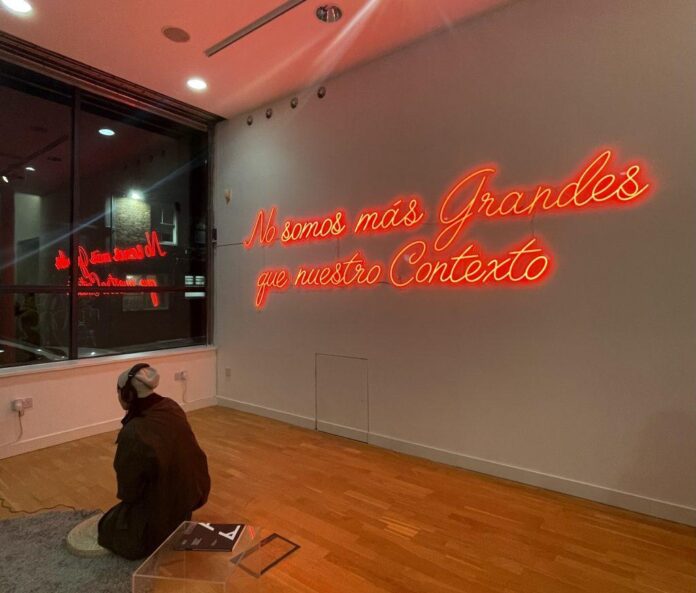The light was back on and jovial chatter was heard again at the corner of Thomas Street in the U.K.’s Manchester this month. After a long hiatus, one of the most prominent centers dedicated to Chinese contemporary art in the west has reopened its doors with a new identity that embraces much wider East and Southeast Asian roots.
Esea Contemporary opened with a group exhibition called “Practise Till We Meet,” which was a demonstration of the center’s determination to start all over again. Featuring an ensemble of ethnically East and Southeast Asian artists presenting bodies of work that explore the diasporic experience, as well as trauma, this modest exhibition is a deliberate move to bid farewell to its past life as the Centre for Chinese Contemporary Art.
The venue went through a major overhaul following the art community’s allegations of institutional racism (the center’s former management team and its board of trustees was dominated by white names) that nearly got the non-profit defunded. But some are not sure the institution has gone far enough.

“Practise Till We Meet” (2023) installation view, at Esea Contemporary. Photo courtesy Jules Lister.
The launch event also coincidentally coincided with the re-opening of the Manchester Museum after a £15 million ($18 million) facelift, which now includes the U.K.’s first permanent gallery dedicated to South Asian art. Although London remains the largest home to Asians, according to a 2021 census, the region that encompasses Manchester also has one of the highest presence of Asian populations in the U.K. Asians, including Chinese and other Asian ethnicities, are among the second biggest ethnic groups in Manchester.
The selection of works and artists in Esea’s debut show “Practise Till We Meet,” curated by the Guangzhou-based independent curator Hanlu Zhang, can be interpreted as a statement for the center’s direction. Although most of the works on show are not new, they address current, unresolved issues facing many in the Asian diaspora.

Koki Tanaka, Vulnerable Histories (A Road Movie) (2018), commissioned by Migros Museum of Contemporary Art. Courtesy of the artist. Photo: Jules Lister.
Memorable works include Koki Tanaka’s (2018), a multi-channel video installation that charts the discrimination, violence, and trauma experienced by the Korean diaspora in Japan, descendants of Korean migrants who came to the country during various wars. The honest discussion about their psychological struggle with their hybrid identities is particularly moving.
A colorful series of photos— (2017-2018), (2018), (2018)—by the Manchester-based Audrey Albert, a native of the island of Mauritius, in the Indian Ocean, who has Chagossian origins. With these poignant works, she introduces the audience to the lesser known history about her displaced roots.

Isaac Chong Wai, Two-Legged Stool (2023), commissioned by Esea Contemporary. Courtesy of the artist. Photo: Jules Lister.
Liu Weiwei’s mixed media project (2017) tells the story about the artist’s younger brother Liu Chao, who is adamant about emigrating to Australia. Although the project was created nearly six years ago, Liu Chao’s determination to leave his native China echoes today amid the recent “run movement” in the country, which is seeing Chinese people fleeing their home country.
Berlin-based Hong Kong artist Issac Chong Wai presents (2023), the only new work commissioned by Arts Council-backed Esea Contemporary. The work, which creates an optical illusion of a stool that appears to be two-legged from one angle, and three-legged from another, references the late Chinese leader Deng Xiaoping’s 1980s remarks about the complicated relationship between China, the U.K., and Hong Kong. “There have been talks of the so-called three-legged stool. [There are] not three legs, only two legs,” he had noted. The work is shown alongside Chong’s acclaimed video series (2018), which depicts the slow body movements seen in protests and the police’s tackle of demonstrators.
While the show attempts to serve as a platform for diverse narratives, and while efforts have been made to be inclusive (the curator’s statement in Chinese is printed in traditional Chinese characters, which are used in Hong Kong and Taiwan, rather than simplified characters adopted in mainland China), some members of the East and Southeast Asian communities in the U.K. that Artnet News spoke with remain skeptical about the center’s re-launch.

A viewer admiring Audrey Albert’s work Matter Out of Place on show at exhibition “Practise Till We Meet” at Esea Contemporary. Photo: Jules Lister.
The new Asian presence in the institution’s leadership appears to include members who are predominantly of Chinese heritage. “What about the representation of other cultures from East and Southeast Asia on the management level? I would prefer to wait and see what they are going to do next,” said one Manchester-based East Asian culture practitioner who declined to be named.
In response to such concerns, an Esea Contemporary spokesperson said they “welcome the community’s engagement and reflection to help us achieve what we are setting out to construct: a platform for the ESEA art community at large.”
“We plan to work with a diverse range of guest curators across future projects, as well as continuing efforts to grow our board of trustees, staff team and artistic advisory panel,” the Esea spokesperson told Artnet News.
There is reason for optimsim; the center’s director Xiaowen Zhu is busy cooking up big plans for the coming year. Two more shows have been planned, and she is looking into diversifying the center’s programming to include more live, in-person events.
“No terminology is perfect in terms of representation. We hope we are doing the right thing. We are also figuring things out along the way,” said Zhu. “People’s excitement and curiosity are definitely very encouraging for us.”
More Trending Stories:
Whoops! A Clumsy Art Fair Visitor Shattered a $42,000 Jeff Koons Balloon Dog Sculpture in Miami

























